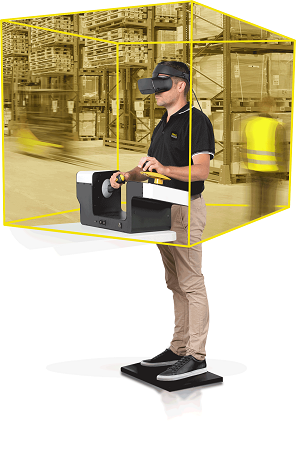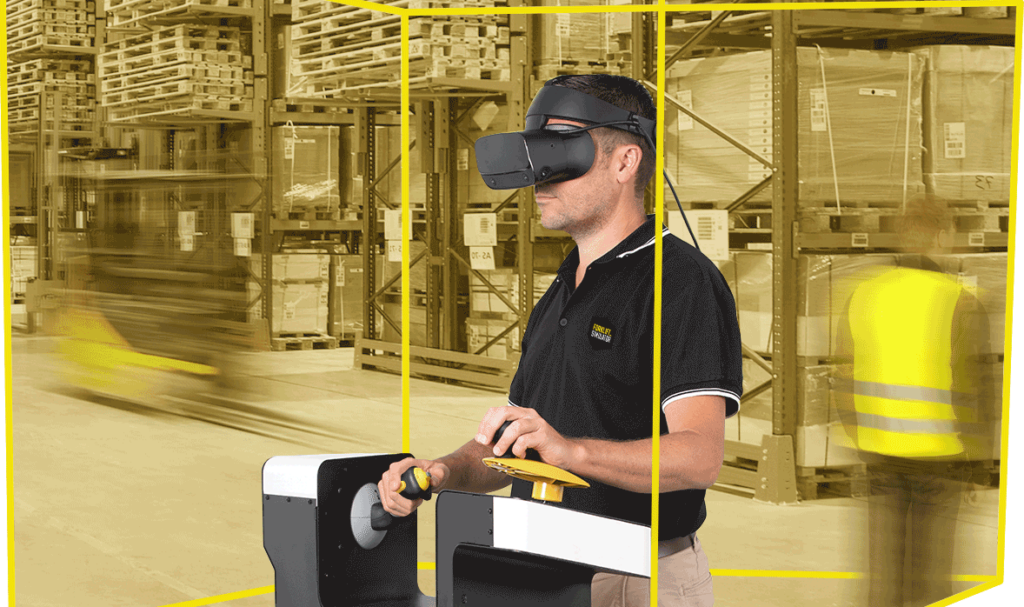Forklift accidents can result in bone fractures and crushed limbs. In extreme cases, even loss of life for employees. Safety procedures are critical to ensure employees stay safe in the workplace. Standards are in place by the Occupational Safety and Health Administration (OSHA). The standards help to protect employees from injuries.
Every company must protect its employees as best as it can. Forklift operators need the best training to create safe work environments. Traditional training methods have helped in the past. But forklift simulator training is a more modern tool. It can assist organizations in meeting robust OSHA standards.
This article follows Forklift Safety and Compliance: Benefits of Virtual Training and What are 5 Common Compliance Mistakes with Forklift Trucks.
The Benefits Of Forklift Simulator Training
Meeting regulatory requirements is critical for companies to ensure compliance. Forklift simulator training can help organizations meet compliance obligations, amongst many other benefits.
Improved operator safety
It gives a hands-on training experience in a safe virtual environment. Trainee forklift operators can practice using a forklift and learn the safety procedures without risk.
Reduced risk of potential accidents and injuries
Forklift simulator training lets operators experience and learn from different hazardous scenarios. If something goes wrong during the training, it won’t cause an accident or injury.
Increased productivity for the organization
Simulator training can also increase the business’s productivity. Modern, state-of-the-art simulator training guides operators to work in the best way. This effective way of working follows on into their actual job after training.
Lower training costs for the business
Forklift simulator training is cheaper. Businesses don’t need to use actual forklift equipment. It also reduces the risk of damaging company items or places in the warehouse.
Improved compliance with OSHA regulations
This type of training also helps organizations improve their compliance. The simulator trains operators to meet industry standards. The company has more chance of meeting its compliance obligations.
Forklift Training And Compliance
OSHA’s primary goal is to ensure companies follow compliance measures. The onus is on organizations to train, check, and certify their employees.
Training is a rule by law. OSHA states operators must have training and certification before they use a forklift. Forklift training saves lives, OSHA believes 77% of forklift accidents are preventable with training.
Who handles certification?
Because OSHA does not accredit or certify trainers or training programs. The burden of certification is 100% on the employer. (The exception to this are OSHA’s 10-hour and 30-hour outreach programs).
- An outside training provider can guarantee that their training meets OSHA standards.
- This provider can verify that an operator has received the training necessary.
- The employer can only do the certification.
The employer must certify that the employee has completed the training needed to do the role. Also, the employee must confirm that the employee has the necessary competency.
The same rules on certification also apply to any new employees the company takes on board. To follow the rules and regulations, forklift employees must have a certificate.
Forklift operator training
Employers must follow OSHA standard 1910.178. It requests that operators train for maintenance and vehicle inspections. It is also worth noting that operators must be over 18 years old. Certification is every three years.
Organizations, by law, must use a written program that includes the following:
- Forklift operator training
- A set system to grant a license
- A consistent review/renewal of the program
The above points are an OSHA rule that applies to every forklift truck operator. Employers must cover all areas of forklift operations. For example, monitoring forklift speeds, setting the parking brake, etc.
OSHA and Forklift Operator Training
While the burden of certification rests with the employer, it can be time-consuming and frustrating for employers. Forklift simulator training comes into its own here. It can deliver what both the employer and OSHA need.
OSHA Training Requirements
There are many OSHA training requirements. Regarding forklift operator training, it must include three specific sections. These sections are formal instructions, practical training, and evaluation. Here are the set requirements for each one:
- Formal Instruction
This part of the training gives the background information that an operator needs. The training can be via a lecture, reading a book, watching a video, or using software of some description.
- Practical Training
This stage of training involves hands-on instructions and live demonstrations. Practice exercises on a forklift truck are possible if a trainer provides supervision.
- Evaluation
The third area is checking how the operator performs in the workplace. By law, every three years, operators have to receive new evaluations. It ensures operators are up to date with all the safety requirements and can do the role.

Forklift Simulator Training Makes A Positive Difference
It’s worth remembering the worker’s rights under The Occupational Safety and Health Act of 1970. As part of the act, it is a requirement by law for workers to receive the best training to ensure they are safe at work.
Meeting regulatory requirements is critical to ensure the safety and health of employees. Forklift simulator training takes the compliance burden away from companies. It makes it easier for businesses to follow laws and OSHA standards.
The training requirements detailed by OSHA are robust. Organizations have to stay compliant or suffer the consequences. Forklift simulation training can help organizations to meet these demanding OSHA requirements.
Learn Safety Procedures In A Risk-Free Environment
Forklift operators can learn about load capacities, the proper use of seatbelts, and stability. It helps employers meet OSHA requirements and reduces workplace accidents.
Regulation and Industry-Specific Training Software
The software can address every standard or regulation stipulated by OSHA. It can also cover any industry-specific area due to its customizable options. The company can feel assured that the operators receive the most appropriate training.
Adapt To New Regulations
It is also possible to change the training for operators if regulations change. This flexibility is ideal for keeping abreast of changing rules and regulations. It means the training will always be able to meet compliance requirements.
It’s Practically The Real Thing
There are sit-down counterbalance forklift simulators with genuine controls, steering, and a seat. It feels practically like the real thing. Or, as an alternative, there are desktop options. It is the perfect introduction to forklifts for new operators.
Forklift Simulator Training In Action
Companies must work with reputable companies that provide effective virtual reality training. Forklift Simulator is a leader in virtual reality forklift simulation. The company has already worked with organizations globally.
Its simulator training helps to ensure compliance with OSHA regulations. Highlights are proprietary VR software that has the best-in-class graphic. Different detailed environments also help to give a realistic experience.
Moving Forward With Forklift Simulator Training
Although some training will still need to be with a human, forklift simulator training is a powerful tool. It can help modern organizations remain agile. Also, it can make compliance more manageable by following industry rules and regulations.
Virtual training helps companies meet OSHA standards and keeps employees safe. Also, when standards change in the future or new rules and regulations appear. The training software can be upgraded quickly, saving precious time and money.
10 Steps To Prevent Forklift Incidents In Your Workplace is the next article in the series. Click here to read the 1st and 2nd articles.
